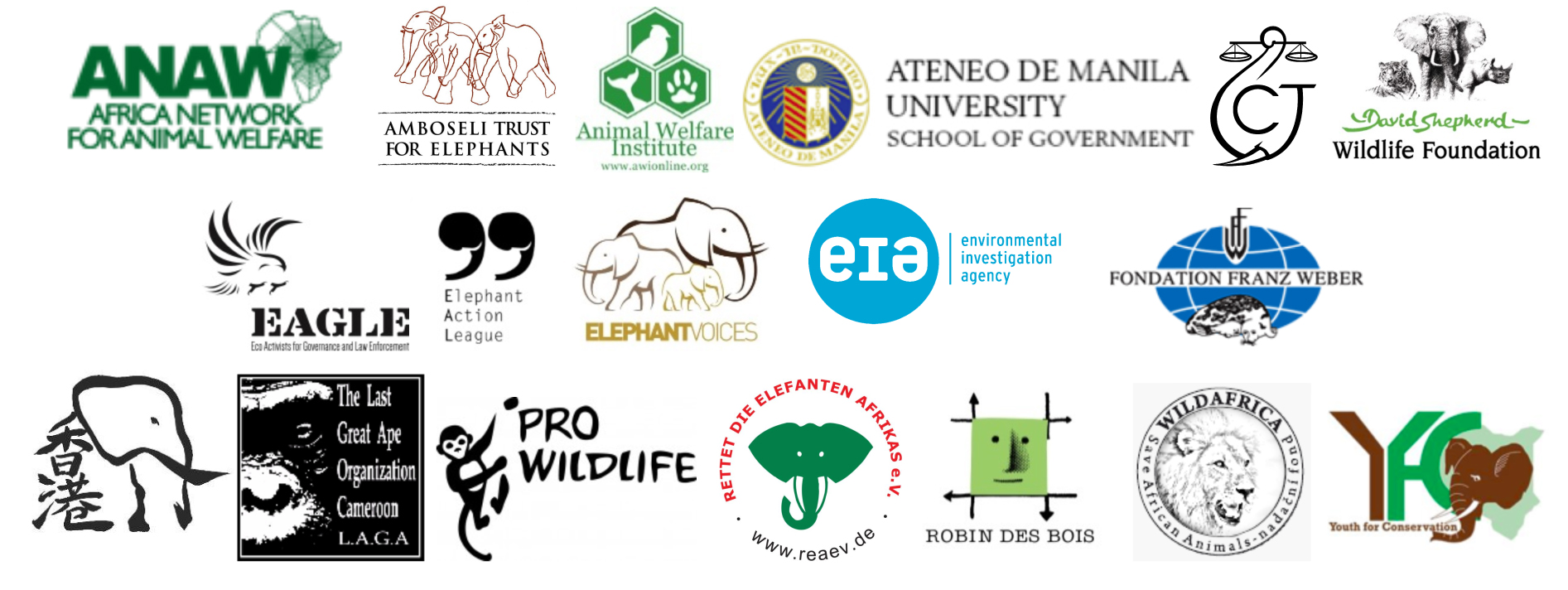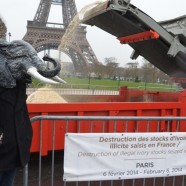Good news and Happy New Year!
Two joyful major events simultaneously occurred and must be celebrated.
1 – For the first time in 27 years, Japan has been banned from harpoon fishing whales in Antarctica. Hundreds of sea mammals thus avoid suffering from pain and death, thanks to a brittle but tangible truce allowing southern hemisphere whales to finally be given a blow-er.
2 –Tamil Nadu’s (India) 98 domestic elephants are on vacation from December 11, 2014, to January 27, 2015. They’ve all been trucked and gathered into two camps – one for religious-use elephants, one for forest landscaping-use elephants – to undergo rejuvenation and physical and mental health monitoring. Meanwhile, mahouts are taught how to better take care of their pachyderms.
“On the Trail” n°6
Wildlife is bubbling
“On the Trail” n°6, 134 pages of beauty and cruelty
Information and Analysis bulletin on animal poaching and smuggling.
Rhinoceroses and elephants, pages 60 to 97
Open parcels and find poisonous scorpions, search a shop in Malaysia and stumble on a vial of elephant sperm, find out about the latest trafficker’s tricks, meet the rhino mafia, hunt the MGM lion and discover the Tibetan Wild Ass, or Kiang.
Introduction: Several recent studies suggest that violence on animals and abuse of animal’s weakness show predisposition to violence against humans and that witnessing domestic violence or being submitted to parental harassment leads to a predisposition to violence against animals. Violence is a viral and vicious circle …
“On the Trail” n°5
We are pleased to announce the publication of the 5th edition of « On the Trail », Information and analysis bulletin on animal poaching and smuggling.
1st April – 30th June 2014. 132 pages, 506 events.
Rhinoceroses and elephants, pages 68 to 105
English version (pdf 7,2 Mo):
https://robindesbois.org/wp-content/uploads/ON_THE_TRAIL_5.pdf
Numerous messages have been sent to Robin des Bois from Africa, Asia, Europe and the American continent. They come from Custom officers, CITES delegates, governmental institutions, Non-Governmental Organizations and from the general public. They all testify to the usefulness of “A la Trace” and the English version “On the Trail”, », Information and analysis bulletin on animal poaching and smuggling.
Europe – An Open Market For The Ivory Trade ?
Conservationists urge the EU – the biggest exporter of so-called “old” ivory – to ban all ivory trade
Brussels/2 June 2014. On the eve of inter-governmental meetings in Brussels and Geneva in June and July to debate the fate of elephants, a group of conservation organisations requests all EU governments to urgently halt all commerce in ivory and to destroy all remaining stockpiles. New data shows escalating exports of ivory from the European Union to China and worldwide. The organisations warn that any legal loophole in ivory trade creates the opportunity to launder poached ivory into “legal” trade and thus fuels the killing of elephants.
French Riviera Pensioners Endangering Elephants
France, the first European country to destroy its illegal ivory stockpile – 3.4 tonnes in February 2014 – has, at the same time, become a hub for international trade in ivory. Through the intermediary of the Cannes Auction House, raw or carved elephant tusks from 42 elephants were put up for auction on March 8th and May 3rd 2014. Together they weigh 1.4 tonnes. If we believe the discourse of the Cannes Auction House director the French Riviera is populated by old expatriates who worked in Africa. They returned to France with their arms full and wish to increase their pensions and spend their days in tranquillity overlooking the Mediterranean Sea, far from the AK47 bullets harassing African elephants.
“On the Trail” n°4
Here now the 4th edition of « On the Trail »
Information and analysis bulletin on animal poaching and smuggling.
1st January – 31th March 2014.
112 pages, 468 events, 352 information sources.
Rhinoceroses and elephants, pages 62 to 90
All dials are in the red. On the endangered species market prices are soaring. China and the world exotic pet trade are weighing heavily. The red-fronted parrot in Congo smuggled by Blue Helmets are sold for 800 US$ on Internet. Rhino horns reach 100,000 US$/kg, leopard skin more than 30,000 US/$. Mumbai golden youth gets high on cobra venom (180,000 US$/l). Isilo, the elephant who became a symbol of South Africa, is dead. His 2 tusks worth 600,000 US$ have disappeared. Poachers were the first to find his body by spotting the vultures. Suspicion lingers. Daytime rangers become night-time poachers. Prices go wild, the violence does also. Animals, thieves and rangers fall. Traffickers kill each other like traffickers of a drug cartel. Gangs rule, gangrene thrives. This is war. Justice is incoherent. From severe punishment to set an example to a mere bail, justice sometimes goes astray. Traffickers are often very young. Poachers ride BMWs. Killing methods are both modern and archaic.
(Français) L’interdiction du commerce de l’ivoire est indispensable pour sauver les éléphants
“On the Trail” n°3
Quarterly information and analyses bulletin on animal poaching and smuggling (pdf 80 p. 4.5 Mo) with a special item on the scheduled French illegal ivory crushing tomorrow.
Rhinoceroses and elephants, pages 48 to 69
Here’s to China for the Elephants!
Today, China destroyed some of the stockpiles of illegal elephant ivory seized along and within its borders.
In accordance with CITES* Decisions, the traders accredited by the Chinese government bought, at auctions, 60 tonnes of ivory in 2008 from 4 countries in southern Africa, Zimbabwe, Botswana, Namibia, and South Africa. The average price was 157 US$/kg, ten times less expensive than black market rates at the time. Following this 172 workshops and retail stores were supplied elephant tusks benefiting from a specific license.













